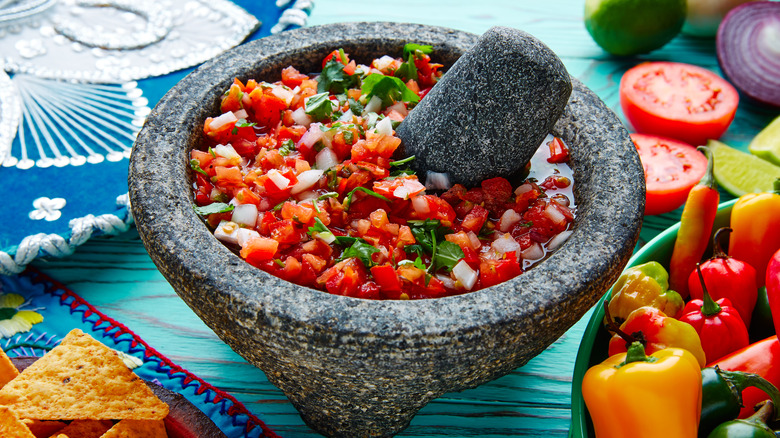The Telltale Sign That Your Molcajete Is The Real Deal
The molcajete — a traditional Mexican mortar and pestle used for grinding ingredients — holds much more importance to the culinary world than just a means of making tableside guac. The ancient cooking tool carries a rich history dating back thousands of years when it was first utilized by the Aztecs and Mayans to grind spices, chilis, and corn. Evolved from an earlier rectangular iteration called a metate, the molcajete is still popular in modern Mexican kitchens and restaurants and is often passed down through generations as a family heirloom, along with culinary secrets and treasured tales of family meals past. Additionally, with the expansion of its use into a wide array of molcajete salsas, sauces, and pestos, it's also an excellent alternative to a modern food processor, and — when cured properly — it helps add flavor to the food prepared in it.
However, it's important to note that all molcajetes aren't the same, and some of those available for purchase aren't nearly as authentic as they appear. Luckily, there are some methods of determining the authenticity of your molcajete and whether or not you have the genuine article in your kitchen or simply an imitation.
How to tell if your molcajete is the real deal
An authentic molcajete is made from a piece of volcanic stone that has been formed and chiseled into a three-legged bowl by the hands of master artisans. But while the craftsmanship may be impressive, like most handmade things, an authentic molcajete will possess slight imperfections. So, the first and easiest way to tell if your molcajete is the real deal is to examine the surface. A genuine molcajete will be uneven and not quite symmetrical, and you'll notice flaws in the bowl and legs and uneven pores on the surface. If your piece's pores are uniform, it's likely a cement piece. You can also test its authenticity by leaving some water in the bowl. An authentic molcajete will retain the water you left inside. Conversely, a cement piece will absorb the water, similar to the way ground cement does when it's drenched. So if you pour a little water into your molcajete and it disappears after a few minutes, you've got an impostor on your hands.
You'll also be able to test the authenticity of your molcajete by scratching it. If you scratch it with a knife and it leaves a deep mark, it's likely cement or a cement-and-stone combo. And if you're still unsure, give it a sniff. Cement has a distinctive smell, so you'll know pretty quickly if your molcajete is a fake.
How to use your molcajete
Before using your authentic molcajete, it's important to prepare it, and curing it is the first crucial step. To start, you'll want to grind some rock salt or dry rice inside the bowl to remove any stone debris and repeat the process until the salt or rice no longer appears discolored. Then rinse your molcajete with water only (never use soap, as the stone is porous, and you don't want your salsas and dips to have a soapy flavor), and let it air dry.
You'll then want to grind some garlic cloves, onion, rice, and even cilantro or cumin seeds to season the molcajete. Spread the paste all around the inside of the mortar and let it sit overnight — then you're ready to rinse it away and start using it. Alternatively, you can also "bake" your molcajete — with the paste inside — for about 30 minutes at 300 degrees Fahrenheit to allow it to fully absorb the flavors — like the heirloom pieces that have been well-used over time — then rinse when it has cooled. Once your molcajete is cured and seasoned, you're ready to embark on the delectable worlds of guacamole, salsa, sauces, and pesto.


